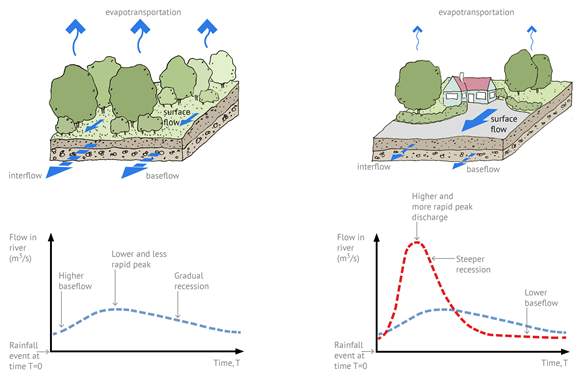- Delivering SuDS
- Using SuDS
- Background
- SuDS principles
- Benefits of SuDS
- Benefits of SuDS
- Why developers should choose SuDS
- Flood risk management
- Water quality management
- Biodiversity & ecology
- Amenity
- Air quality
- Building temperature
- Carbon reduction and sequestration
- Crime
- Economic growth
- Enabling development
- Flexible infrastructure/climate change adaptation
- Education
- Groundwater recharge
- Health and well being
- Pumping wastewater
- Rainwater harvesting
- Recreation
- Tourism
- Traffic calming
- Treating wastewater
- SuDS components
- SuDS components overview
- Source control
- Swales & conveyance channels
- Filtration
- Infiltration
- Retention & detention
- Wetlands
- Inlets, outlets and control structures
- SuDS performance & monitoring
- Delivery
- The costs & benefits of SuDS
- Adoption & maintenance of SuDS
- Legislation & regulation
- Design guidance
- Retrofitting SuDS
- Drainage exceedance
Flood risk management benefits
Development often alters natural drainage by replacing free draining ground with impermeable surfaces, gullies, pipes, sewers and channels. Also, it can remove vegetation and compact the ground. These changes increase the total volume and flow of runoff and may make areas more susceptible to flooding locally but also exacerbate river flooding.

Our climate is also changing, and recent research on climate change suggests that:
- winters may become milder and wetter with more intense rainfall events
- summers may be hotter and drier across the UK
- extreme weather events may become more frequent, eg heat waves, cold snaps and heavy rainfall.
Drainage systems need to adapt to and manage extreme events including flooding and periods of drought, while helping to reduce our carbon emissions. SuDS schemes can be designed to slow water down (attenuate) before it enters a watercourse, provide areas for water storage in natural contours, and can be used to allow water to soak (infiltrate) into the ground, be evaporated from surface water and/or transpired from vegetation (known as evapotranspiration).
Depending upon the design, conveyance and storage techniques SuDS can reduce the frequency and/or severity of flooding if the scale and size of the measures can accommodate larger rainfall events. This in turn leads to a number of benefits (eg reduced damage to property, avoided stress and anxiety), as the pathway diagram below shows.
Read more on:



